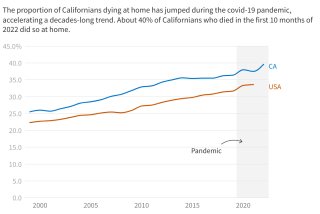Who lives and who dies? With ventilators limited amid coronavirus, doctors might face hard choices

It’s a choice most doctors never thought they would have to make: Who lives and who dies.
But in coming weeks, if COVID-19 continues to surge, such decisions will be inevitable.
The coronavirus will attack so many people’s lungs that thousands could show up at hospitals gasping for air and will need to be hooked up to machines that breathe for them. But there won’t be enough ventilators for everyone, forcing doctors to make impossible calls about which lives to save.
“You have an 80-year-old and a 20-year-old and both need a vent and you only have one. What do you do?” said Dr. Christopher Colwell, the chief of emergency medicine at Zuckerberg San Francisco General Hospital and Trauma Center.
Across the U.S., there could be as many as 31 patients requiring ventilation for every machine available, according to an article published this week in the New England Journal of Medicine. The shortage could be just as severe in California.
Statewide, there are about 9,500 ventilators, a total that includes recent additions made by state leaders and others in anticipation of increased numbers of COVID-19 patients. The federal government’s national stockpile, which states can tap when their local supplies run low, has an additional 16,000.
Gov. Gavin Newsom has not said how many ventilators he thinks California will ultimately require, but studies in China found that between 2% and 6% of people with COVID-19 needed to be on ventilators.
If half of Californians fall sick with COVID-19 and 2% need ventilators, the state would need 390,000 over the course of the outbreak. Even if those cases were spread out over the next year, the state could still require 20,000 ventilators at once.
“It could be catastrophic,” said Dr. Robert Winters, an infectious disease doctor in Los Angeles.
Doctors will have to resort to a wartime-like triage to determine whom to put on the ventilators and whom to turn away. In Italy, hospitals have been forced to deny potentially live-saving treatment to older, frailer people due to a shortage of machines.
These are difficult decisions anywhere, but particularly in America, where families often push for extreme measures to keep people alive even when they are very sick, experts say. And they aren’t choices that medical workers, who trained for years to save lives, want to make.
Colwell, the San Francisco doctor, said he is already considering what to do in such a situation. The city’s hospitals have about 750 ventilators and officials are trying to obtain others from reserve supplies, he said.
“How do I distribute them in an equitable manner that tries to honor the approach of the good of the many versus the good of the few?” Colwell said. “Does it mean lives saved, years of life saved or quality of life?
“There’s not a black and white answer,” he said.
In the New England Journal of Medicine article, a trio of Harvard Medical School experts called decisions about who gets ventilators “the toughest triage.”
“Although rationing is not unprecedented, never before has the American public been faced with the prospect of having to ration medical goods and services on this scale,” they wrote. “Of all the medical care that will have to be rationed, the most problematic will be mechanical ventilation.”
Ventilators supply oxygen to people who can’t get enough and also physically push air in and out of the lungs. Infections can debilitate patients and weaken their muscles so they cannot contract and expand on their own.
Rationing such care has been the subject of ongoing discussions at Sutter Health Network, where one of those weighing in said she believes the best model is to allow a panel of doctors, instead of individual physicians, to decide who receives the care, said Dr. Janice Manjuck, a critical care specialist at an Oakland hospital.
“One particular physician does not have the bird’s eye view of what is out there,” she said, adding that as a doctor caring for a patient, “you are probably not the best to make that decision because you always advocate for the patient.”
Ventilators, she said, “can be the difference between life and death.”
With COVID-19, it remains unclear how often that is the case. One small study published in the medical journal the Lancet found that of 37 patients in Wuhan who were ventilated, only seven survived.
Dr. Lewis Rubinson, a New Jersey intensivist who wrote a guide for physicians caring for critically ill patients with COVID-19 that was published by the Society for Critical Care Medicine, said that based on the literature and information sharing in the intensivist community, about half of patients who get ventilated for COVID-19 survive, with chances of survival dropping with age.
In recent weeks, he has had first-hand experience in ICU treatment of these patients in his post as chief medical officer of Morristown Medical Center. He said his advice to places that haven’t been hit as badly as the New York metro area is: “Don’t squander time. This is when to get ready.”
New York, now the national epicenter of the outbreak, recently procured 7,000 ventilators in addition to the roughly 4,000 that were already available in the state, according to Gov. Andrew Cuomo. But at least 30,000 more will be needed to cope with the ongoing outbreak, he said in a press briefing Tuesday.
“What happens to New York is going to wind up happening to California and Washington state and Illinois — it’s just a matter of time. We’re just getting there first,” he said.
Cuomo said that doctors may try an experimental technique of putting as many as four people on a single ventilator. Shortages in other states may eventually prompt similar measures born of desperation, experts say.
“You can’t let somebody die in the parking lot because you can’t ventilate them,” said Winters, the L.A. doctor. “I’ve never seen two people on one ventilator in my entire life but it beats the alternative of dying of respiratory failure.”
In extreme situations, a lack of ventilators could also mean that staff use a hand-held pump to push air in and out of patients’ lungs, said Dr. Wally Ghurabi, ER medical director at UCLA Medical Center in Santa Monica.
In Los Angeles County, there were 833 ventilators available across the county’s 70 public and private hospitals this week, according to a survey by the county’s Emergency Services Agency. The county department that runs the four local public hospitals is working to acquire an additional 313, according to a statement.
If there aren’t enough ventilators, one hospital with extras could theoretically lend some to another facility that is running short, said Cathy Chidester, head of the county’s EMS agency. She said she thinks L.A. County won’t be inundated at once, because of how spread out the region is.
“A hospital over here that isn’t seeing that influx of patients. ... They could move the ventilators over if push came to shove,” Chidester said. “The beauty of L.A. County is it’s broad. It’s 4,000 square miles — it’s not like New York, it’s not like China.”
Other places already severely impacted by COVID-19 have offered horror stories that have put U.S. providers on edge. In one hospital in Lombardy, a hard-hit region in northern Italy, doctors reported patients in the hospital sleeping on mattresses on the floor. There, 70% of the ICU beds are reserved for COVID-19 patients “with a reasonable chance to survive,” the doctors wrote in a recent paper.
“The situation here is dismal,” they wrote. “Older patients are not being resuscitated and die alone without appropriate palliative care, while the family is notified over the phone, often by a well-intentioned, exhausted, and emotionally depleted physician with no prior contact.”
Experts say these end-of-life decisions will be particularly tough for people to accept in America, where much more money is typically spent to keep very sick people alive than in the rest of the world.
California and particularly L.A. County have some of the highest rates of spending in the last six months of people’s lives, according to the Dartmouth Atlas of Health Care, a Dartmouth University-led project documenting how medical resources are distributed in the U.S.
“As it stands in the U.S., if your family member is adamant that you would want everything done and you’re 90 years old, wearing a diaper, severely demented, you would get put on a ventilator,” said Dr. James Keany, ER physician at Providence Mission Hospital in Mission Viejo. ”Most countries consider that malpractice because what are you saving that person for?”
Many Americans believe life needs to be protected at all costs, he said, but “we may not have that luxury if this disease explodes.”
Dr. Arthur Jey, an emergency room doctor who works at a Sutter Medical hospital in downtown Sacramento, said there are ongoing discussions about how to ration care at his facility, but if there is a shortage, he plans to also ask patients if they want to be ventilated.
He said he has often been surprised by older patients who tell him firmly that they don’t want any additional medical measures.
“We think a lot of people want to live no matter what, but over the years, I have been taken aback by so many people who have said, ‘No, I’m OK.’” he said. “There are people who would say, ‘You know what, save somebody else.’”
He said the fundamental question medical providers will ask themselves in these tough situations is: “Do I think I can pull them through?”
If the answer is no, the ventilator might go to someone else, he said.
“It’s terrifying.”










